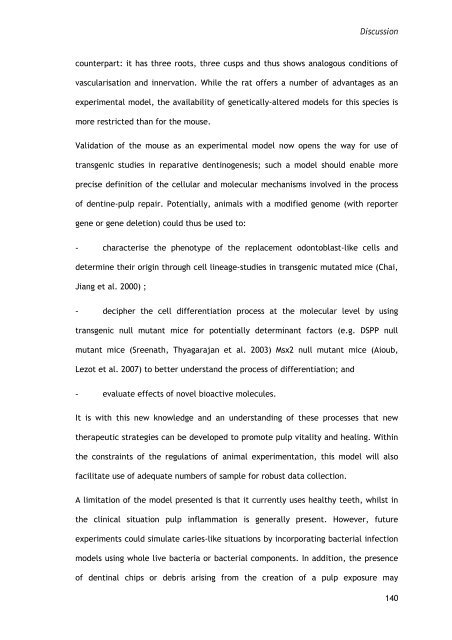Molecular characterisation of odontoblast during primary, secondary ...
Molecular characterisation of odontoblast during primary, secondary ...
Molecular characterisation of odontoblast during primary, secondary ...
You also want an ePaper? Increase the reach of your titles
YUMPU automatically turns print PDFs into web optimized ePapers that Google loves.
Discussion<br />
counterpart: it has three roots, three cusps and thus shows analogous conditions <strong>of</strong><br />
vascularisation and innervation. While the rat <strong>of</strong>fers a number <strong>of</strong> advantages as an<br />
experimental model, the availability <strong>of</strong> genetically-altered models for this species is<br />
more restricted than for the mouse.<br />
Validation <strong>of</strong> the mouse as an experimental model now opens the way for use <strong>of</strong><br />
transgenic studies in reparative dentinogenesis; such a model should enable more<br />
precise definition <strong>of</strong> the cellular and molecular mechanisms involved in the process<br />
<strong>of</strong> dentine-pulp repair. Potentially, animals with a modified genome (with reporter<br />
gene or gene deletion) could thus be used to:<br />
- characterise the phenotype <strong>of</strong> the replacement <strong>odontoblast</strong>-like cells and<br />
determine their origin through cell lineage-studies in transgenic mutated mice (Chai,<br />
Jiang et al. 2000) ;<br />
- decipher the cell differentiation process at the molecular level by using<br />
transgenic null mutant mice for potentially determinant factors (e.g. DSPP null<br />
mutant mice (Sreenath, Thyagarajan et al. 2003) Msx2 null mutant mice (Aioub,<br />
Lezot et al. 2007) to better understand the process <strong>of</strong> differentiation; and<br />
- evaluate effects <strong>of</strong> novel bioactive molecules.<br />
It is with this new knowledge and an understanding <strong>of</strong> these processes that new<br />
therapeutic strategies can be developed to promote pulp vitality and healing. Within<br />
the constraints <strong>of</strong> the regulations <strong>of</strong> animal experimentation, this model will also<br />
facilitate use <strong>of</strong> adequate numbers <strong>of</strong> sample for robust data collection.<br />
A limitation <strong>of</strong> the model presented is that it currently uses healthy teeth, whilst in<br />
the clinical situation pulp inflammation is generally present. However, future<br />
experiments could simulate caries-like situations by incorporating bacterial infection<br />
models using whole live bacteria or bacterial components. In addition, the presence<br />
<strong>of</strong> dentinal chips or debris arising from the creation <strong>of</strong> a pulp exposure may<br />
140
















